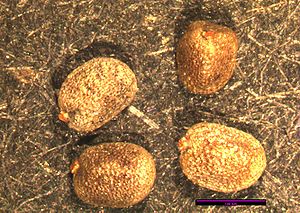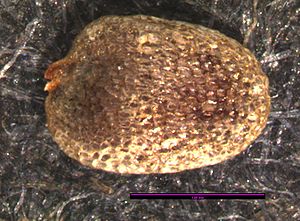Barbarea orthoceras
Contents
Taxonomy
SCIENTIFIC NAME: Barbarea orthoceras FAMILY: Brassicaceae ENGLISH NAME: American yellow-rocket, American wintercress
Description
General: Mostly glabrous biennial from a taproot and simple crown, the stems stiff, erect, angled, single but freely-branched, 2-6 dm. tall. Leaves: Basal leaves long-petiolate, up to 12 cm. long, the blade usually lyrate-pinnatifid to pinnate, the lateral lobes 8-10, entire to round-toothed, the terminal lobe ovate, entire or irregularly toothed, the petiole often with long, marginal hairs; cauline leaves alternate, similar to the basal but reduced upward, becoming simple and sagittate. Flowers: Inflorescence of compound or single and terminal racemes, with reduced racemes in the lower leaf axils; pedicles stout, 2-3 mm. long; sepals 4, pale yellowish-green, 2 mm. long; petals 4, yellow, spatulate-oblanceolate, 3-5 mm. long; stamens 6; style beak-like, 0.5-2 mm. long; stigma slightly lobed. Fruit: Siliques 1.5-5 cm. long and 1.5-2.5 mm. broad, slightly compressed, 4-angled, strongly 1-nerved full length, erect or strongly ascending, nearly straight.
Bloom Period
Apr-May
Distribution
Alaska to the mountains of California, east though the Rockies to the New England states.
Habitat
Meadows, stream banks and moist woods, low to mid-elevations in the mountains. It is hardy to zone 0. The flowers are hermaphrodite (have both male and female organs) and are pollinated by Flies, bees, beetles. The plant is self-fertile. The plant prefers light (sandy), medium (loamy) and heavy (clay) soils and requires well-drained soil. The plant prefers acid, neutral and basic (alkaline) soils. It can grow in semi-shade (light woodland) or no shade. It requires moist soil.
Uses
First Nations use rosettes of the dark green shiny leaves can be cooked or eaten raw in a salad
Propagation
Sow seeds in situ in early spring to early summer.Succeeds in sun or shade in a moist well-drained soil
Seed
Abbreviation: BAOR
Seed sample from: 2011
Average Measurement: 1.6 x 1.1 x 0.8
Measurement Range: L: 1.4 - 1.9, W: 1 - 1.3, D: 0.7 - 1
Features
Color: Hilum reddish and pinched looking. Seed is brownish red.
Surface:Some concave pitting on seed surface. Entire seed is covered with a net veined pattern giving it a scaly appearance. Seed is shiny.
Latitudinal Cross Section: elliptical ![]()
Longitudinal Cross Section: elliptical ![]()
Basic Explanations and Assumptions:
The dimensions for the seeds are length x width x depth. The location of the hilum is used as the base of the seed, and the length is measured from hilum to the opposite apex. Where a style is present, the length is measured from the hilum to the bottom of the style. Width is measured at a right angle to the length at the widest part. Depth is measured at a right angle to the intersection of height and width lines.
Measurements included are the mean average for each measurement of ten separate seeds.
All measurements in millimeters unless otherwise noted.




